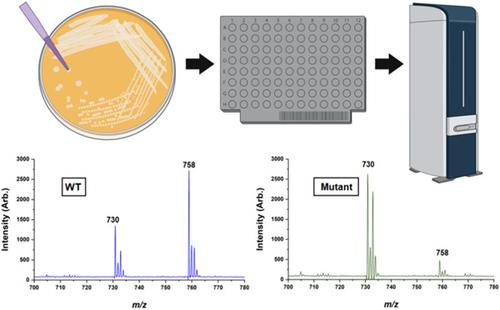当前位置:
X-MOL 学术
›
Biotechnol. Bioeng.
›
论文详情
Our official English website, www.x-mol.net, welcomes your
feedback! (Note: you will need to create a separate account there.)
A mass spectrometry-based high-throughput screening method for engineering fatty acid synthases with improved production of medium-chain fatty acids.
Biotechnology and Bioengineering ( IF 3.5 ) Pub Date : 2020-03-26 , DOI: 10.1002/bit.27343 Pu Xue 1, 2, 3 , Tong Si 1, 3, 4 , Shekhar Mishra 1, 3 , Linzixuan Zhang 1 , Kisurb Choe 2, 3, 5 , Jonathan V Sweedler 2, 3, 6 , Huimin Zhao 1, 2, 3, 5, 6
Biotechnology and Bioengineering ( IF 3.5 ) Pub Date : 2020-03-26 , DOI: 10.1002/bit.27343 Pu Xue 1, 2, 3 , Tong Si 1, 3, 4 , Shekhar Mishra 1, 3 , Linzixuan Zhang 1 , Kisurb Choe 2, 3, 5 , Jonathan V Sweedler 2, 3, 6 , Huimin Zhao 1, 2, 3, 5, 6
Affiliation

|
Microbial cell factories have been extensively engineered to produce free fatty acids (FFAs) as key components of crucial nutrients, soaps, industrial chemicals, and fuels. However, our ability to control the composition of microbially synthesized FFAs is still limited, particularly, for producing medium‐chain fatty acids (MCFAs). This is mainly due to the lack of high‐throughput approaches for FFA analysis to engineer enzymes with desirable product specificity. Here we report a mass spectrometry (MS)‐based method for rapid profiling of MCFAs in Saccharomyces cerevisiae by using membrane lipids as a proxy. In particular, matrix‐assisted laser desorption/ionization time‐of‐flight (MALDI‐ToF) MS was used to detect shorter acyl chain phosphatidylcholines from membrane lipids and a higher m/z peak ratio at 730 and 758 was used as an indication for improved MCFA production. This colony‐based method can be performed at a rate of ~2 s per sample, representing a substantial improvement over gas chromatography‐MS (typically >30 min per sample) as the gold standard method for FFA detection. To demonstrate the power of this method, we performed site‐saturation mutagenesis of the yeast fatty acid synthase and identified nine missense mutations that resulted in improved MCFA production relative to the wild‐type strain. Colony‐based MALDI‐ToF MS screening provides an effective approach for engineering microbial fatty acid compositions in a high‐throughput manner.
中文翻译:

一种基于质谱的高通量筛选方法,用于改进中链脂肪酸产量的工程脂肪酸合酶。
微生物细胞工厂经过广泛设计,可生产游离脂肪酸 (FFA),作为关键营养素、肥皂、工业化学品和燃料的关键成分。然而,我们控制微生物合成 FFA 组成的能力仍然有限,特别是在生产中链脂肪酸 (MCFA) 方面。这主要是由于缺乏高通量的 FFA 分析方法来设计具有理想产品特异性的酶。在这里,我们报告了一种基于质谱 (MS) 的方法,通过使用膜脂作为代理快速分析酿酒酵母中的 MCFA 。特别是,基质辅助激光解吸/电离飞行时间 (MALDI-ToF) MS 用于检测膜脂中较短的酰基链磷脂酰胆碱和较高的m/z730 和 758 处的峰值比率被用作改善 MCFA 产量的指标。这种基于菌落的方法可以以每个样品约 2 s 的速率进行,这比作为 FFA 检测金标准方法的气相色谱-MS(通常每个样品 > 30 分钟)有了显着改进。为了证明这种方法的功效,我们对酵母脂肪酸合酶进行了位点饱和诱变,并确定了九个错义突变,这些突变导致相对于野生型菌株的 MCFA 产量提高。基于菌落的 MALDI-ToF MS 筛选提供了一种以高通量方式改造微生物脂肪酸组成的有效方法。
更新日期:2020-03-26
中文翻译:

一种基于质谱的高通量筛选方法,用于改进中链脂肪酸产量的工程脂肪酸合酶。
微生物细胞工厂经过广泛设计,可生产游离脂肪酸 (FFA),作为关键营养素、肥皂、工业化学品和燃料的关键成分。然而,我们控制微生物合成 FFA 组成的能力仍然有限,特别是在生产中链脂肪酸 (MCFA) 方面。这主要是由于缺乏高通量的 FFA 分析方法来设计具有理想产品特异性的酶。在这里,我们报告了一种基于质谱 (MS) 的方法,通过使用膜脂作为代理快速分析酿酒酵母中的 MCFA 。特别是,基质辅助激光解吸/电离飞行时间 (MALDI-ToF) MS 用于检测膜脂中较短的酰基链磷脂酰胆碱和较高的m/z730 和 758 处的峰值比率被用作改善 MCFA 产量的指标。这种基于菌落的方法可以以每个样品约 2 s 的速率进行,这比作为 FFA 检测金标准方法的气相色谱-MS(通常每个样品 > 30 分钟)有了显着改进。为了证明这种方法的功效,我们对酵母脂肪酸合酶进行了位点饱和诱变,并确定了九个错义突变,这些突变导致相对于野生型菌株的 MCFA 产量提高。基于菌落的 MALDI-ToF MS 筛选提供了一种以高通量方式改造微生物脂肪酸组成的有效方法。











































 京公网安备 11010802027423号
京公网安备 11010802027423号